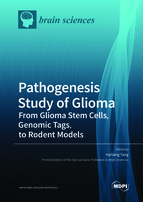Pathogenesis Study of Glioma: From Glioma Stem Cells, Genomic Tags, to Rodent Models
A special issue of Brain Sciences (ISSN 2076-3425). This special issue belongs to the section "Neuro-oncology".
Deadline for manuscript submissions: closed (26 June 2022) | Viewed by 23765
Special Issue Editor
Interests: traumatic brain injury; brain tumors; stem cells
Special Issues, Collections and Topics in MDPI journals
Special Issue Information
Dear Colleagues,
Despite the past two decades of research progress, glioma still remains the most challenging of all primary central nervous system (CNS) tumors. The complexity of its pathogenesis makes the disease hard to deal with, especially glioblastoma multiforme (GBM, WHO grade IV), the most aggressive brain tumor entity.
GBMs contain a population of glioma stem cells (GSCs) with self-renewal ability, which are partly responsible for tumor resistance and recurrence after standard therapy. Researchers recently also found that neural stem cells (NSCs) in the subventricular zone are a potential cell of origin, containing the driver mutations of GBM. In this Special Issue, we encourage manuscripts discussing common features between GSCs and NSCs, and that provide possible future therapeutic strategies.
Numerous genomic findings in glioma deeply impact both basic research and clinical outcomes. For example, the genetic alterations IDH1/2, NF1, ERBB2, and NFKBIA provide opportunities for the discovery of new drugs. Although current glioma treatment is still mainly based on traditional pathology, genomic tags now have an increasing role in clinical diagnosis, and assist in making treatment plans. In this Special Issue, we also welcome manuscripts discussing genomic findings in glioma.
Mouse models have also been widely used to investigate the cell of origin of glioma. Researchers have already reported the first genomic study of a mouse model of high-grade astrocytoma by manipulating tumor suppressors, including PTEN, P53, and Rb. It was shown that there was a close similarity in gene copy number and alteration between mouse glioma and human sample. This Special Issue welcomes manuscripts discussing glioma models in rodents and their value for future preclinical studies.
Thus, we are organizing a Special Issue in the journal Brain Sciences, with the aim to collect studies that focus on the pathogenesis of glioma, such as its cell origin, the role of GSCs, genomic alterations, animal models, etc. Original articles, clinical trials, and reviews related to this topic, but not case reports, are welcome for submission to this Special Issue.
Dr. Hailiang Tang
Guest Editor
Manuscript Submission Information
Manuscripts should be submitted online at www.mdpi.com by registering and logging in to this website. Once you are registered, click here to go to the submission form. Manuscripts can be submitted until the deadline. All submissions that pass pre-check are peer-reviewed. Accepted papers will be published continuously in the journal (as soon as accepted) and will be listed together on the special issue website. Research articles, review articles as well as short communications are invited. For planned papers, a title and short abstract (about 100 words) can be sent to the Editorial Office for announcement on this website.
Submitted manuscripts should not have been published previously, nor be under consideration for publication elsewhere (except conference proceedings papers). All manuscripts are thoroughly refereed through a single-blind peer-review process. A guide for authors and other relevant information for submission of manuscripts is available on the Instructions for Authors page. Brain Sciences is an international peer-reviewed open access monthly journal published by MDPI.
Please visit the Instructions for Authors page before submitting a manuscript. The Article Processing Charge (APC) for publication in this open access journal is 2200 CHF (Swiss Francs). Submitted papers should be well formatted and use good English. Authors may use MDPI's English editing service prior to publication or during author revisions.
Keywords
- glioma
- stem cells
- genomic
- pathogenesis







